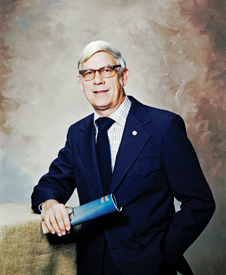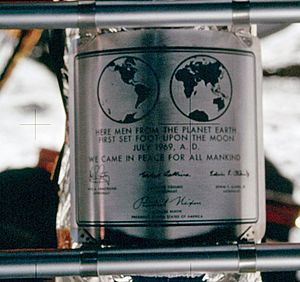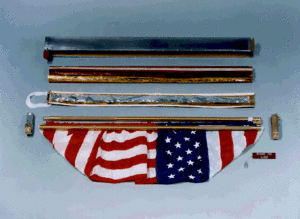Jack Kinzler facts for kids
Quick facts for kids
Jack Albert Kinzler
|
|
|---|---|
 |
|
| Born | January 9, 1920 Pittsburgh, Pennsylvania, U.S.
|
| Died | March 4, 2014 (aged 94) |
| Other names | Mr. Fix It |
| Occupation | Engineer |
Jack Kinzler (January 9, 1920 – March 4, 2014) was a brilliant NASA engineer. He was known as Mr. Fix It because he could solve tough problems for the space agency. Jack Kinzler led the Technical Services Center at NASA's Johnson Space Center in Houston.
He won the NASA Distinguished Service Medal, which is a very important award. He earned it for creating a special solar shield that saved Skylab, the first U.S. space station. The original shield was damaged during launch. Kinzler also helped create the American flag and plaques used on the Moon during the Apollo program missions. He even helped make the special golf club that astronaut Alan Shepard used to hit golf balls on the Moon!
Contents
Jack Kinzler: NASA's "Mr. Fix It"
From Model Planes to Space
Jack Kinzler was born in Pittsburgh, Pennsylvania. His father was an inventor who worked with photos. From a young age, Jack loved building model planes. He was so good at it that he competed in contests. He even turned down a scholarship to college so he could keep following his passion for airplanes.
His amazing model-building skills helped him get a job with the National Advisory Committee for Aeronautics (NACA). At NACA, he built models for wind tunnel tests. These tests helped engineers understand how planes would fly. In 1958, NACA became the main part of the new National Aeronautics and Space Administration, or NASA. Kinzler continued his important work there.
In 1961, Jack Kinzler started the Technical Services Division at the Johnson Space Center in Houston. This division had about 180 skilled people. They were experts in many areas like working with metal, welding, electronics, and making models. They built many of the tools and parts needed for the space program. Kinzler led this team until he retired in 1977.
Helping Astronauts on the Moon
Jack Kinzler and his team made many important things for the Apollo missions. These were the missions that landed astronauts on the Moon.
The Moon Flag Mystery
NASA wanted to place an American flag on the Moon. But there's no air on the Moon, so a flag wouldn't wave like it does on Earth. NASA first thought about just printing a flag on the side of the Apollo Lunar Module. This was the part of the spacecraft that landed on the Moon.
But Kinzler had a better idea! He suggested the Lunar Flag Assembly (LFA). This was a special telescoping pole with a horizontal bar. It would fit into a pocket at the top of the flag. This made the flag look like it was flying in a strong wind, even with no air. Kinzler said he got the idea from watching his mother hang curtains when he was a child.
Messages Left on the Moon
Kinzler also designed the special commemorative plaques left on the Moon by each Apollo landing mission. These plaques were made of stainless steel. They had copies of the signatures of all the astronauts on the mission and the U.S. president. They also showed pictures of Earth.

The plaque from the Apollo 11 mission had a famous message. It said, "Here men from the Planet Earth first set foot upon the Moon. July 1969 AD. We came in peace for all mankind."
Golfing on the Moon!
Jack Kinzler also helped create a very unique item for the Moon. He helped make a special golf club head. Astronaut Alan Shepard attached this head to a lunar sampling scoop. He then used it to hit two golf balls on the Moon during the Apollo 14 mission!
Kinzler's team also made other important tools. These included the Hand-Held Maneuvering Unit. Astronaut Ed White used this unit during the Gemini IV mission. It was used for the first spacewalk by a U.S. astronaut. They also made a flexible rubber boot. This boot was placed between a space capsule and its heat shield. It helped soften the landing when the capsule splashed down in the ocean.
Saving Skylab, the First Space Station
A Big Problem in Space
On May 14, 1973, NASA launched Skylab. This was the United States' first space station. But during the launch, something went wrong. A shield meant to protect Skylab from tiny space rocks ripped off too early. This also tore off one of the station's solar panels. Another solar panel couldn't open all the way.
Without its shield, Skylab was getting too hot from the sun. It also didn't have enough electricity because of the damaged solar panels. The temperature inside the station rose dangerously. This threatened to ruin important film and food. It could even make the station unsafe for astronauts because overheated plastic parts might release toxic gases.
The "Space Parasol" Solution
Jack Kinzler quickly looked for a solution. He wanted to fix the problem without needing a dangerous spacewalk by the Skylab crew. His idea was to create something like a parasol or umbrella. This device could be pushed through a small 8-inch (20 cm) opening in the station's hull.
He built a test version using four telescoping fiberglass fishing rods and parachute silk. Kinzler's design allowed the device to be pushed out from inside Skylab. Then, springs and telescoping tubes would make it open up. His model convinced NASA leaders that it would work.
On May 26, the Skylab crew entered the station. They deployed the special parasol. It was made of aluminized material and measured about 24 by 28 feet. The parasol successfully shielded Skylab from the sun's heat. This allowed the station to cool down to a safe temperature of about 70°F (21°C).
Kinzler was very proud that the parasol was designed and built almost entirely by government employees. "We stayed awake and worked for six solid days, around the clock," he said. "We had a hundred employees working on this thing, and we did everything. We made all the parts. We demonstrated how it's to be done. And we completely pulled that thing off without any outside help."
For his amazing work that saved Skylab, Jack Kinzler received the NASA Distinguished Service Medal in 1973.


